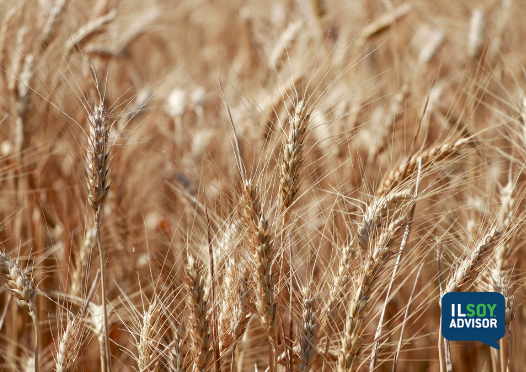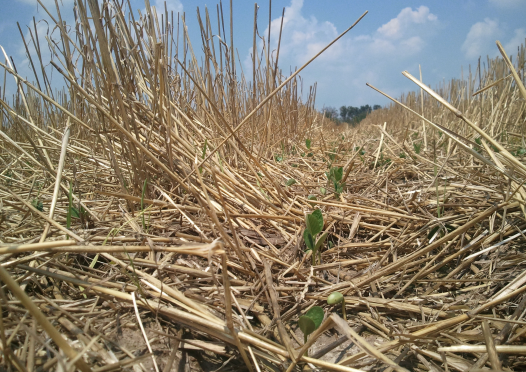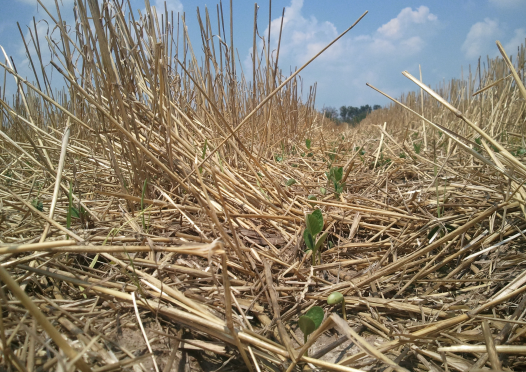ILSOYADVISOR POST
Agronomy: Prepare for wheat planting
If you are a double-cropper, the rotation all begins with the wheat you plant this fall, so it is important to do everything you can to get that crop off to a good start.
As the 2016 harvest approaches, remember that what you do at harvest will affect stand establishment in your winter wheat. As you prepare grain bins, auger wagons, trucks and the combine to harvest corn and beans, you also need to prepare the wheat drill to plant behind them. What you do with the combine, grain carts and trucks in the field will affect the performance of the drill – and ultimately the performance of your wheat crop. It’s important to think in tandem as you approach wheat seeding.
Let’s start with the wheat drill. Ensure that all units are performing properly. Replace any bearings, disc blades, seed boots and gauge wheels that are worn or out of spec. Inspect the seed tubes for cracks, breaks and obstructions -- it’s not uncommon to find a seed tube that has dry rotted or has a nest of some type in it after a long, hot summer of sitting in the shed. Look at the metering device and ensure it is working properly.
Next, “zero” out all those row units to ensure each will be planting at the same depth -- nothing is worse than having some row units planting deeper or shallower than the intended depth, as this will affect emergence. Likewise, it is important to ensure that down-pressure springs are zeroed out as well. This ensures uniform pressure on each seed unit and helps provide a uniform planting depth. Lastly, be sure to zero out the metering units and calibrate them to the desired seeding rate. This often can be accomplished on drills by disengaging the drive chain and manually turning the drive shaft a given number of revolutions and then measuring the seed output of selected meters.
Once you have your drill set up and ready, it’s time to check that the combine is set up properly to ensure good seed bed conditions for your wheat. The combine should cut the previous crop evenly and distribute the straw/stalks/stems evenly behind the combine. Adjust the head for a low, close cut. The chopper also should reduce the size of the harvested material to as small a particle as possible. Replace chopper blades or veins that are worn or damaged. The combine must be able to distribute the chaff evenly across the width of cut. Check and adjust the spreading device on the back of the combine and replace any missing or worn parts. A fine, even distribution of harvested material is necessary—especially in a no-till situation—to ensure an even planting depth and promote consistent emergence.
Lastly, especially in a no-till setting, minimize the auger cart and truck traffic in the field. Cleat marks and ruts from auger carts and trucks can lead to inconsistent planting depth and uneven emergence. Remember this when you are seeding into a freshly harvested field without the benefit of a winter freeze and thaw cycle to remediate that compaction. It’s critical to do everything you can to minimize compaction.
A properly set up and adjusted wheat drill does little good in a field that has been left in a mess by the combine and support equipment, and you may need extra tillage passes to fix what issues the combine leaves behind. In a no-till situation, those faults could be the difference between a good stand and no stand. Remember that the combine is the first step in establishing a good wheat crop in 2017.
Kelly is serving as the Illinois Soybean Association Double-Crop Specialist. He was raised on the family farm in Benton, Illinois and graduated from Southern Illinois University (SIU)-Carbondale with a BS in Agriculture Education and Mechanization, and a Master’s of Science (MS) in Plant and Soil Science. Kelly has spent 25 years as a soil fertility agronomist and precision agriculture consultant in southern Illinois while also spending 4 years as a Farm/Agronomy Manager and GIS Coordinator for a large farm in southeastern Illinois. He is a Certified Professional Agronomist and a Certified Crop Advisor.





Comments
Add new comment